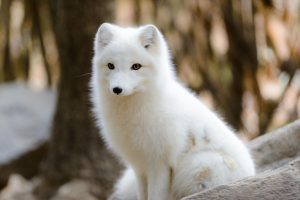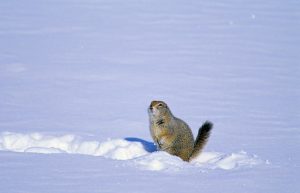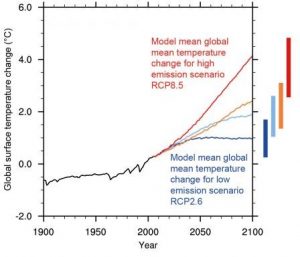
In the eyes of an arctic fox (Alopex lagopus), the temperatures of the tundra provide seamless living conditions. Their adaptations to low temperatures make their arctic habitats suitable for them to hunt, reproduce and in turn survive. However, their survival is threatened by increasing temperatures in the arctic, as it has become more suitable for red foxes (Vulpes Vulpes), too (Killengreen et al., 2007). As the red fox invades the territory of the arctic fox, they undergo competition for land and prey. Although this has not led to a direct decline in arctic fox numbers, it can have further impacts on food webs and community dynamics within the Arctic ecosystem (Gallant et al., 2012).
This is just an example of the new reality in the Arctic; ice is melting due to increased temperatures, and the ecosystem is changing vastly (Serreze et al., 2000). Many of us are aware that global temperatures are rising due to increased greenhouse gas emissions entering the atmosphere, however the rate of temperature change varies across the globe. Where average temperatures have increased by 0.4°C over the past 150 years, it is believed that warming in arctic regions has been almost 3 times higher (IPCC, 2014).
The increased warming creates an environment which is suitable for other, non-native species (Post et al., 2009) – such as the example of the Red Fox. Species towards the South of the Arctic have increased their range, placing pressure on the existing Arctic communities (Root et al., 2003). This ‘invasion’ is not limited to animal species; invasive species in the form of plant communities can also intrude on the ecosystem. For example, the warming has allowed shrub tundra to expand into a wider variety of habitats, and Boreal forest has begun to infringe on the tundra ecosystem (Hinzman et al., 2005).

Another example is of the arctic ground squirrel (Urocitellus parryii), which acts as an ecosystem engineer through its key role in the food web (Wheeler, 2011). The arctic ground squirrel burrows into vegetated land as a mechanism for survival. The burrowing action also changes the composition of the soil, which is important for other ecological processes. However, as boreal, woody forests become more prominent than the easily accessible vegetation, the arctic ground squirrel loses its habitat (Donker & Krebs, 2011).

The Arctic ecosystem is so complex that the full effects of climate change are not yet understood. This means that the invasive species described above have the potential to interrupt even more ecological processes and food webs. This could also affect human livelihood as we also rely on the stability of the food chain for survival. Furthermore, global warming is expected to cause temperatures to increase even more, dependent on emissions scenarios (Figure 1). This would cause the number of invasive species in both terrestrial and marine ecosystems to increase, threatening the existing communities to an even greater extent.
References
Donker, S. A., Krebs, C. J. (2011) Habitat Specific Distribution and Abundance of Arctic Ground Squirrels (Urocitellus parryii) in Southwest Yukon. Canadian Journal of Zoology, 89, 570-576.
Gallant, D., Slough, B. G., Reid, D. G., Berteaux, D. (2012) Arctic fox versus red fox in the warming Arctic: four decades of den surveys in north Yukon. Polar Biology, 35(9), 1421-1431.
Hinzman, L. D., Bettez, N. D., Bolton, W. R. et al. (2005) Evidence and Implications of Recent Climate Change in Northern Alaska and Other Arctic Regions. Climatic Change, 72(3), 251-298.
IPCC (2013) Climate Change 2013: The Physical Science Basis. Contribution of Working Group I to the Fifth Assessment Report of the Intergovernmental Panel on Climate Change. Cambridge University Press, Cambridge, United Kingdom and New York, NY, USA, 1535 pp.
IPCC (2014) Climate Change 2014: Synthesis Report. Contribution of Working Groups I, II and III to the Fifth Assessment Report of the Intergovernmental Panel on Climate Change. IPCC, Geneva, Switzerland, 151 pp.
Killengreen, S. T., Ims, R. A., Yoccoz, N. G., Brathen, K. A., Henden, J., Schott, T. (2007) Structural Characteristics of a Low Arctic Tundra Ecosystem and the Retreat of the Arctic Fox. Biological Conservation, 135(4), 459-472.
Post, E., Forchhammer, M. C., Bret-Harte, S. M. et al. (2009) Ecological Dynamics Across the Arctic Associated with Recent Climate Change. Science, 325(5946), 1355-1358.
Root, T. L., Price, J. T., Hall, K. R., Schneider, S. H., Rosenzweig, C., Pounds, J. A. (2003) Fingerprints of Global Warming on Wild Animals and Plants. Nature, 421, 57-60.
Serreze, M. C., Walsh, J. E., Chapin, F. S., III, Osterkamp, T., Dyurgerov, M., Romanovsky, V., Oechel. W. C., Morison, J., Zhang, T., Barry, R. G. (2000) Observational Evidence of Recent Change in the Northern High Latitude Environment. Climate Change, 46, 159-207.
Wheeler, H. C. (2011) Arctic Ground Squirrels Urocitellus parryii as Drivers and Indicators of Change in Northern Ecosystems. Mammal Review, 43, 238-255.
[479 Words]
Recent Comments